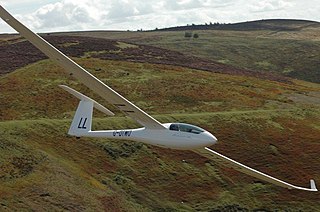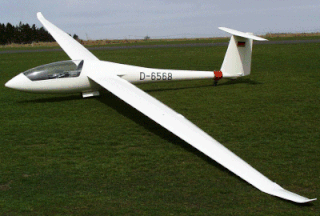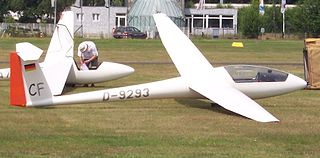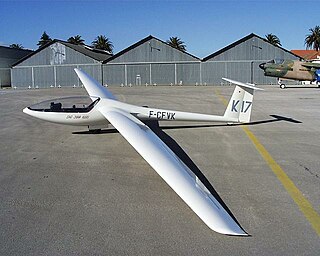
The Schempp-Hirth Discus-2 is a Standard Class sailplane produced by Schempp-Hirth since 1998. It replaced the highly successful Schempp-Hirth Discus.

The Schempp-Hirth Ventus is a sailplane produced during 1980–1994 by Schempp-Hirth, a German sailplane manufacturer. It was designed by Klaus Holighaus and replaced the Schempp-Hirth Mini-Nimbus. Schempp-Hirth manufactured 613 Ventus sailplanes.

The Schempp-Hirth Ventus-2 is a sailplane produced by Schempp-Hirth since 1994. It replaced the highly successful Schempp-Hirth Ventus.

The Rolladen-Schneider LS4 is a Standard Class single seat glider manufactured by Rolladen-Schneider Flugzeugbau GmbH between 1980 and 2003.

The Schempp-Hirth Mini Nimbus is a 15 Metre-class glider designed and built by Schempp-Hirth GmbH in the late 1970s.

The Rolladen-Schneider LS1 is a Standard Class single-seat glider manufactured in Germany by Rolladen-Schneider from 1968 to 1977.

The Schempp-Hirth Janus is a high performance two-seat glider that was built by Schempp-Hirth GmbH. It was the first high-performance two-seater.

The Standard Cirrus is a German Standard-class glider built by Schempp-Hirth. The Standard Cirrus was produced between 1969 and 1985, when it was replaced by the Discus. Over 800 examples were built, making it one of the most successful early fibreglass glider designs.
The Schempp-Hirth HS-3 Nimbus was a prototype glider built by Klaus Holighaus.

The Schempp-Hirth Nimbus-2 is an Open Class glider built by Schempp-Hirth during the 1970s. The Nimbus-2 first flew in April 1971 and a total of over 240 examples of all subtypes have been built until the beginning of the 1980s. It replaced the Schempp-Hirth Cirrus.

The Schempp-Hirth Nimbus 3 is a glider built by Schempp-Hirth.

The Glaser-Dirks DG-300 is a Standard Class single-seat high-performance glider built of glass-reinforced plastic. The DG-300 was designed by Wilhelm Dirks and manufactured by Glaser-Dirks Flugzeugbau's Slovenian partner company Elan (company). A total of 511 of all versions were built since production started in 1983. Representative contemporary types from competing manufacturers are the Rolladen-Schneider LS4 and the Schempp-Hirth Discus.

The ASW 19 is a single-seat glider built by Alexander Schleicher GmbH & Co, first flying in 1975. It was originally designed as a Standard Class glider, but now mainly competes in the Club Class. The ASW 19 is known for its pleasant handling and some clubs use it as a training glider. It was succeeded by the all-new Schleicher ASW 24.

The G102 Astir is a single seat glassfibre Club Class sailplane, designed by Burkhart Grob and built by Grob Aircraft. It was the first Grob-designed sailplane, with the first flight in December 1974. Grob had previously built the Schempp-Hirth Standard Cirrus under licence.

The VSO 10 Vosa is a Standard and Club-Class glider designed and manufactured in the Czechoslovak Republic from December 1978 as a replacement for the VT-116 Orlik II.

The SZD-59 Acro is a single-seat glass composite glider for aerobatics and cross-country flying by PZL Allstar of Bielsko-Biala, Poland.

The Standard Austria was a single-seat aerobatic glider that was originally designed and built in Austria from 1959 but production was moved in 1962 to Schempp-Hirth in Germany.

The SZD-41 Jantar Standard was a Standard Class glider designed and produced in Poland from 1973.

The SZD-48 Jantar Standard 2 is a Standard Class glider that was designed and produced in Poland starting in 1977.

The Schempp-Hirth Ventus-3 is a sailplane produced by Schempp-Hirth. It replaces the highly successful Schempp-Hirth Ventus-2.




















